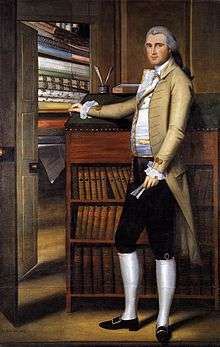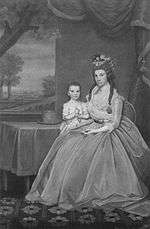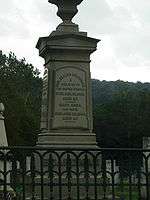Elijah Boardman
| Elijah Boardman | |
|---|---|
 Elijah Boardman, painted by Ralph Earl in 1789 | |
| United States Senator from Connecticut | |
|
In office March 4, 1821 – August 18, 1823 | |
| Preceded by | James Hillhouse |
| Succeeded by | Henry W. Edwards |
| Personal details | |
| Born |
March 7, 1760 New Milford, Connecticut Colony |
| Died |
August 18, 1823 (aged 63) Boardman, Ohio, U.S. |
| Resting place | New Milford, Connecticut |
| Nationality | American |
| Political party | Democratic Republican |
| Children | William Whiting Boardman |
| Residence | Litchfield, Connecticut |
| Alma mater | Home tutored |
| Occupation | Dry goods merchant |
| Religion | Episcopalian |
Elijah Boardman (March 7, 1760 – August 18, 1823) was a senator from Connecticut. Born to a noted and politically connected Connecticut family, he served in the United States Army before becoming a noted merchant and businessman. Becoming involved in property and land ownership in Connecticut and Ohio, he founded the towns of Boardman and Medina. His involvement in politics also increased, and he gradually rose through the ranks of the local, and then national government in the United States Senate. He served as Senator for Connecticut until his death in Ohio.
Biography
Early life
Boardman, an Episcopalian,[1] was born in New Milford in Connecticut, the third of four children for Deacon Sherman Boardman (1728–1814) and Sarah Bostwick Boardman (1730–1818).[2][3] His father, a first minister, was a "prosperous farmer", well educated and well versed in local politics – he was 21 times elected as a member of the General Assembly of Connecticut – and was familiar with "civil and military concerns of the town."[2] The Boardman family were the town's founding family, and lived on a "substantial farm" on the Housatonic River.[3]
A biographer of his later wife wrote of Elijah Boardman: "Inheriting many of the good qualities of his father and his grandfather, he combined, with those good qualities, the energy and intrepidity of his mother and of his grandmother, respecting both of whom there are preserved family traditions of much historical and domestic interest." The biographer also noted Boardman to be "dignified" in personal appearance, and handsome. His brother, Davind Sherman Boardman, remarked that he was "inclined" to hilarity.[2] Elijah Boardman was educated by private tutors – including tutoring in Latin by the Reverend Nathaniel Taylor and other matters by his own mother – at home before enlisting in the local militia to serve in the American Revolutionary War as a "common soldier", in March 1776 aged 16.[2][3]
Revolutionary War
Under Captain Isaac Bostwick, Boardman served in one of the first sixteen regiments raised by the Continental Congress under the command of Colonel Charles Webb. Boardman was directed to Boston, and diverted to New London and New York City, where he took part in Battle of Long Island, however after defeat there and American evacuation to Washington, he was confined to a sick bed having exacerbated childhood medical difficulties and fever.[2] After six months, having achieved an ultimate rank of sergeant,[4] he obtained passage on a wagon back to New York, where he was discovered in poor health by a friend of his father, who sent word home for Boardman to be collected. Meanwhile, Boardman obtained a discharge from the army.[2]
In the summer of 1777, Sir Henry Clinton led British forces through Fort Montgomery and prompted a call-up of Connecticut militia, which Boardman joined until the danger passed following the surrender of General Burgoyne, whereupon the militia was disbanded.[2] Now detached from the army, Boardman resumed his tutorship under John Hickling, a family tutor employed by Boardman's father.[2]
Mercantile employment

In 1781, Boardman took work as a clerk and as a merchant. He spent time employed in New Haven, training as a shopkeeper in the store of Elijah and Archibald Austin,[3] before setting up his own company in his home town of New Milford later that same year.[2][3] This business, a dry-goods store, was operated in conjunction with his two brothers, David and Daniel. As part of his travels, he visited Ohio, where he founded the town of Boardman.[5] In 1789, he was the subject of a portrait by Ralph Earl, which "portrayed the richly dressed dry goods merchant... in his store in New Milford... through the open door, bolts of textiles tell the viewer how Boardman earned a living."[6] Earl's most "accomplished" and successful series of paintings were of the Boardman family.[3] Boardman then married Mary Anna Whiting on September 25, 1792,[2] for whom he would build 'Boardman House', which still stands in New Milford.[5] By this time, he had also opened a second shop outside of any partnership with his brothers, which was situated in Litchfield County and was designed by architect William Sprats, and on October 10, 1794 his first son, William Whiting Boardman, was born.[3]
In September 1795, Boardman became a member of the Connecticut Land Company, and a purchaser of the Connecticut Western Reserve – now part of northern Ohio – which entitled Boardman and his associates to two townships located there, one of which being Medina.[2] The 227-acre (0.92 km2) site set aside to create a county seat was originally named Mecca, until it was realised that a nearby town was named the same. Boardman's land agent, Rufus Ferris Sr., became the first resident of Medina,[7] Together with his brothers, Boardman had thus became the owner of a "considerable" amount of real estate, among the post-Revolutionary War landed gentry "among the town's highest taxpayers."[3]
Politics
Boardman's initial ventures into politics are recorded in a letter to then-President Thomas Jefferson on June 18, 1801. He included a sermon of the Rev. Stanley Griswold, of the New Milford church, which discussed the new President as "an example of how evil could be overcome by good." Jefferson subsequently replied with a detailed critique of the sermon.[8]

Boardman became a member of the State House of Representatives for the period 1803–05 and again in 1816, before becoming a member of the State's upper house between 1817–1819, and a member of the State Senate between 1819–1821.[9] On March 4, 1821, he was elected to the US Senate while living in Litchfield, Connecticut. He is listed by the Abridgment of the Debates of Congress, from 1789 to 1856 as having been present at Senate proceedings on December 3, 1821, in Washington DC in the company of Class-3 Connecticut senator James Lanman.[10]
Later life and death
Boardman served in the Senate until his death during a visit to his son,[2] whereupon he was succeeded by Henry W. Edwards. His cause of death is a subject of speculation, however biographer and son-in-law John Frederick Schroeder (m. Caroline Maria Boardman) related it while writing in 1849 to several bouts of cholera and fever Boardman had suffered throughout his life, particularly during a tour of Rhode Island in 1780, as well as other attacks in Vermont and New Hampshire throughout his life.[2] Senator James Lanman proposed on December 5, 1823, a motion for the members of the Senate to wear "the usual mourning" for thirty days to commemorate his passing.[10] Boardman's body was returned home and interred in New Milford. He was survived by his first son, later politician William,[9] and his second, Henry Mason Boardman.[2] Mabel Thorp Boardman, American philanthropist, was his great-granddaughter.[11]
Notes
- ↑ Purcell, Richard Joseph (1963). Connecticut in transition: 1775–1818. University of Michigan: Wesleyan University Press. p. 181.
- 1 2 3 4 5 6 7 8 9 10 11 12 13 14 Schroeder, John Frederick (1840). Memoir of the Life and Character of Mrs. Mary Anna Boardman. Harvard University: Printed for private distribution. pp. 123–132, 171–172.
- 1 2 3 4 5 6 7 8 Kornhauser, Elizabeth Mankin (1991). ""By Your Inimmitable Hand": Elijah Boardman's Patronage of Ralph Earl". American Art Journal. Kennedy Galleries, Inc. 23 (1): 5–19.
- ↑ Moulton, Ferdinand (1852). Robert Mayo, ed. Army and Navy Pension Laws, and Bounty Land Laws of the United States. University of Michigan: Printed by J. T. Towers. p. 37.
- 1 2 Goodrich, Laurence B. (1967). Ralph Earl, Recorder for an Era. SUNY Press. p. 60. ISBN 0-87395-020-8.
- ↑ "Elijah Boardman, 1789". The Metropolitant Museum of Art. Retrieved 2009-07-26.
- ↑ Brown, Gloria (2007). Arcadia Publishing. pp. 7–12. ISBN 0-7385-4146-X. Missing or empty
|title=(help) - ↑ Dershowitz, Alan M. (2007). Finding Jefferson: a lost letter, a remarkable discovery, and the First Amendment in an age of terrorism. John Wiley and Sons. pp. 51–61.
- 1 2 "BOARDMAN, Elijah, (1760 - 1823)". Biographical Directory of the United States Congress. United States Senate. Retrieved 2009-07-26.
- 1 2 Abridgment of the Debates of Congress, from 1789 to 1856. Volume V. United States Senate. 1858. pp. 137, 471.
- ↑ Joan M. Dixon, ed. (1998). National Intelligencer Newspaper Abstracts, 1821-1823. Heritage Books. p. 184. ISBN 0-7884-0948-4.
References
- Brown, Gloria (2007). Arcadia Publishing. pp. 7–12. ISBN 0-7385-4146-X. Missing or empty
|title=(help) - Kornhauser, Elizabeth Mankin (1991). ""By Your Inimmitable Hand": Elijah Boardman's Patronage of Ralph Earl". American Art Journal. Kennedy Galleries, Inc. 23 (1): 5–19.
- Schroeder, John Frederick (1849). Memoir of the Life and Character of Mrs. Mary Anna Boardman. Harvard University: Printed for private distribution. pp. 123–132, 171–172.
External links
- United States Congress. "Elijah Boardman (id: B000577)". Biographical Directory of the United States Congress.
- Elijah Boardman's Portrait by Ralph Earl at the Metropolitan Museum of Art
| United States Senate | ||
|---|---|---|
| Preceded by Samuel W. Dana |
U.S. Senator from Connecticut (class 1) March 4, 1821 – August 18, 1823 |
Succeeded by Henry W. Edwards |
